WHITE SANDS NATIONAL MONUMENT
RWM
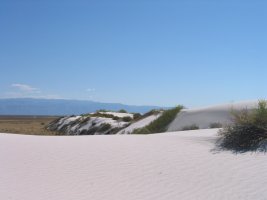
White Sands National Monument is a huge surreal piece of art created and sculptured by the rhythm of the winds. You can step out onto its canvas and become a part of it, adding your footprints to the sands of time. Like the ripples in the sand, your footprints will be swept away and the surface will be a clean slate for the next winds and visitors, human and animal, to create all new patterns and images. Perhaps not today, maybe day after tomorrow, but the winds will come again.
Step out and view the rippling, undulating dunes and ever-changing patterns in the sand that disappear into the distance; the scene is unreal. Like viewing the stilled ocean or the sky, you feel insignificant, but are awed, overwhelmed, overpowered by its silently infinite existence.
White Sands is one of the largest dune fields in the United States; it covers 275 square miles. Rather than quartz, its sands are nearly pure gypsum, fine as sugar, the world’s largest of its kind. When you walk upon it, and it is many feet deep, you do not sink as you would in most sands. The firm, cool surface gives the illusion that it is slightly moist.

Everywhere signs prove the tenacity of life. Plants — most often yucca, but occasionally a tree — perch atop dunes or pedestals, some as high as 60 feet. Their roots reach all the way through the sand, even that hardened into a pedestal by the winds, to the soil beneath it.
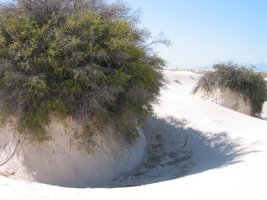
Some animal life — the pocket mouse, the White Sands swift, grasshopper, cricket — adapt to their stark, pristine sand surroundings, to be unseeable by predators, by evolving to a white color. The tenacity of life.
The Basin that contains the White Sands was once, 250 million years ago, the bottom of a shallow sea. The marine deposits turned to stone and uplifted into a giant dome 70 million years ago, during the formation of the Rocky Mountains. About 10 million years ago, the dome collapsed and the Tularosa Basin was formed.
The valley that encompasses White Sands lies at the northern end of the Chihuahuan Desert. The valley — the Tularosa Basin — is surrounded by mountains, the San Andres and the Sacramento mountain ranges. At one time (during the Ice Age), most of the Basin had been a large lake, now named Lake Otero, which is a huge alkali flat. Within this Basin, or valley, is Lake Lucero — a large gypsum playa (a playa is a dry lake bed). It infrequently captures rainwater; as the water evaporates, the gypsum forms crystal beds. Some of the crystals that cover the ground are three feet long. Nature’s many forces — wetting and drying, freezing and thawing — break down the crystals. Winds roll them about, making each of their particles small and smooth and light. Then they are airborne, carried by the strong southwest winds and deposited into ever advancing, moving and undulating fields of sands and dunes.
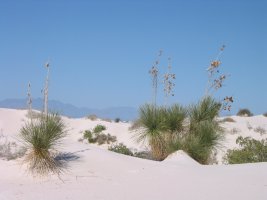
Dunes are of varying shapes and sizes: dome shaped; crescent-shaped ones called barchan dunes; transverse dunes, which are barchan dunes joined together into long ridges of sand; and parabolic dunes, which are found on the edges of the sand fields where plants anchor the arms of barchan dunes and invert their shape.
The unique phenomenon of Lake Lucero, the Tularosa Basin contained by the mountain ranges, and the prevailing winds create the pristine showpiece that is White Sands.
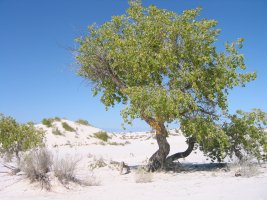
by Jan Girand
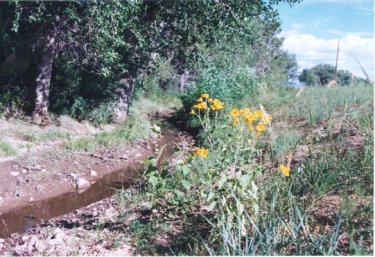
As I walked down the lonely road
of rust and ocher — colors showed
New Mexico’s tones — the strokes were bold,
from autumn’s palette, red and gold.
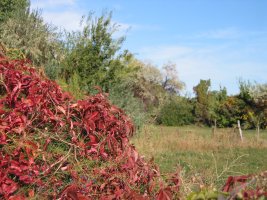
(Autumn color along the Pecos River near Villanueva)
The scents of sage and prickly pear
rose up to greet me, filled the air
with pungent smells of dust and seed
and sunflower stalks and cabbage weed.
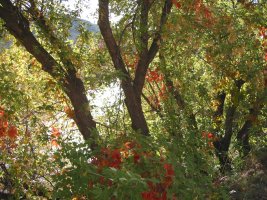
(Pecos River sparkling in sunlight near Villanueva)The sunset spread its dripping hues
of rosy orange, vermillion, blues —
like crayons melting in the light,
de colores ran before the night.
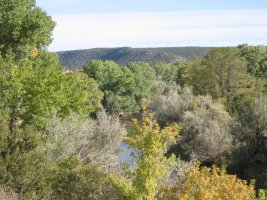
(Fall color along Pecos River)
The glow gave light for me to see
great forests of antiquity;
the mighty oaks bowed down to nod
while begging blessings from their God.
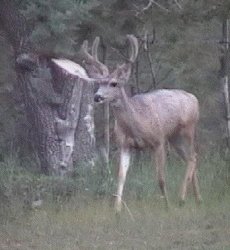
(Deer near Timberon, photo by Carol Bignell)
I hear the cry of a mourning dove
sob of unrequited love ;
the aspens quaked in evening’s light
and pines stood brave against the night.
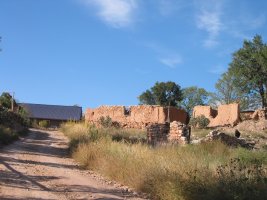
(Villanueva)
At last I found the place I sought:
a silent village long forgot
and left behind so long before —
the final close of a heavy door
on times of carts by oxen pulled
and wheel-spun threads and carded wool
and calico and tatted lace
and patch-work quilts about the place.
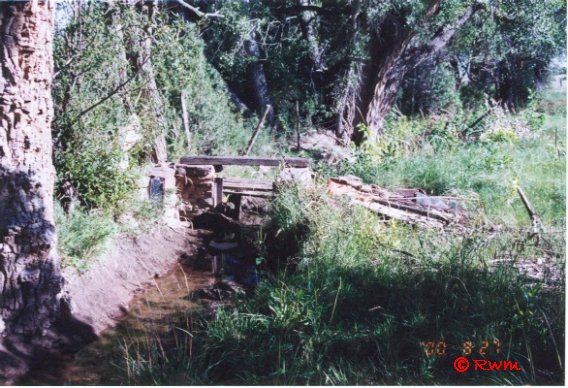
(Ditch dug by James Bonney, about 1841, for his ranch and trading post along the Santa Fe Trail. Col Alexander W. Doniphan and his Missouri Volunteers, and Gen. Stephen Watts Kearny and his Army of the West, spent nights along here as guests of Bonney about August 14, 1846 on their conquest trek of New Mexico and California. There is no doubt Ceran St. Vrain also visited here many times. James Bonney was killed by Indians in October, 1846)
St. Vrain and Kearney and their kin,
land grantees and mountain men,
had passed this way,
their aura spills;
their echoes call down from ancient hills.
A timeless adobe squats in dust:
an old man telling his beads at dusk;
the faded manta falls away
to bare a face of time-worn clay —
was sculpt and smoothed so long ago
by the expert hands of El Senor.
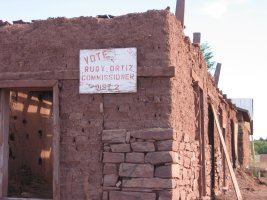
(Villanueva)
The time has ravaged countenance,
and gentle pride has bowed its stance,
yet … adobe of those bygone days
retains its charm in other ways;
those softened lines of melted earth,
like tarnish on silver, proves its worth.
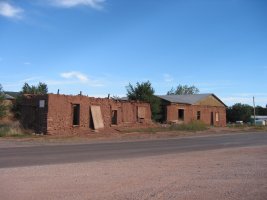
(Villanueva)
An old ghost town that’s gone to seed
is wrapped up now in tangled weeds;
small children’s laughter, woman’s song
once filled the air but now are gone.
Still, signs of life, however faint …
against a wall with faded paint,
in all their glory bloom some stalks
of gold and crimson hollyhocks.
O’er there’s an orchard, mostly dead,
but on one tree are spots of red
and on another, in mid-air,
delicious apples dangle there.
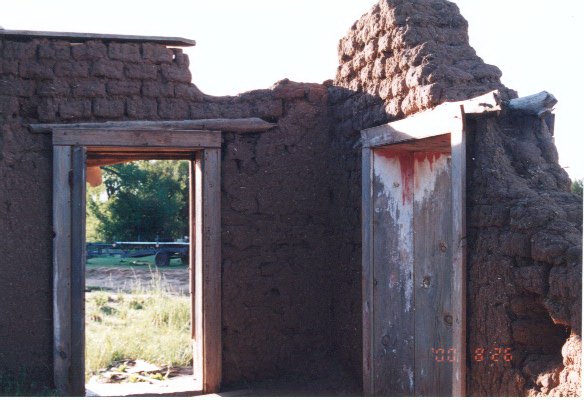
(Inside, looking out, of what had been the home of Cleofas Bonney Lopez)
The well’s gone dry and stock pond too,
all roofs caved in, whole walls are few
The paneless eyes stare sightlessly
midst tumbled bricks and piled debris.
Where once were homes, there’s little left;
those dirt-tracked floors are now windswept.
Just over there a fireplace stands:
a lonely shape in a lonely land.
Adobe needs life, its care a must
or effort-laid bricks return to dust;
erosion and melt of wind and rain
return it back from where it came.
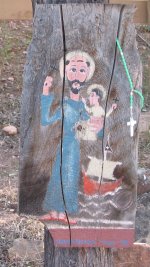
(A roadside Santo at Villanueva)
The warmth of sun that soon must go
still lends its light, a haloed glow,
so on I walk the winding road
over the trail that others strolled.
The camposanto’s silence keeps
its field of dreamers’ endless sleep.
The wooden crosses, daubed with white
are goss’mer figures in twilight.
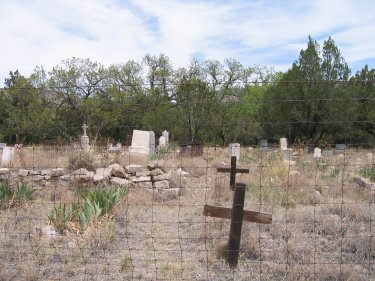
Cemetery at Tinnie near Lincoln
Ah … looming now a church here stands,
was frost with mud by worn brown hands
with loving care, yes, even today
yet chunks of it have fallen away.
An arched bell-tower high above
is just a place for roosting doves,
for long ago, the story’s told,
the bell was taken for its gold.
The battered walls are two-foot thick,
they’re doubled walls of mudded brick,
two-centuries old and arid-cured,
yet gracefully they have endured.
A deep-set window, linteled doors,
inside I know are tamped-dirt floors.
Now walls are mauve as breast of dove,
from twilit glow, like hills above.
Some sparks of light reflect on walls —
a myth from books, I now recall,
of golden cities of long ago …
small flecks of mica cause the glow!
The hand-hewn vigas through walls jut
above the doors that had been cut
by artisanos’ loving skill
so long ago, yet flawless still.
A home of God, a holy place,
serenity and solemn grace …
but also used for other things,
like a retreat from life’s sharp stings.
Those massive walls for years withstood
the raging battles, fire and flood
and hails of spears by Indian raids.
It also saw shy blushing maids
who walked along that narrow aisle,
escorted by Patrone’s smile
and Mama’s tears and sister’s sigh.
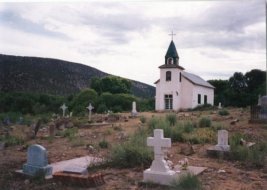
(St. Patrick’s at San Patricio in the Hondo Valley)
That brass-toned bell rang joy on high
up in the loft; it rang before
to warn townsfolk to bar the door.
That missing bell once had its day
imparting news the timeless way.
Rejoicing, joyous tones of cheer,
or warning, calling people here,
or mourning, crying tolling sad …
back then that bell was all they had.
Now, in the autumn twilight air
I sense some things that are not there;
a glimpse of people, things I feel,
a paradox — unreal yet real.
Imagined voice I hear within,
“Forgive me Father, I have sinned …”
I slip within this hallowed place
of peacefulness and holy grace.
Here’s wooden seats in hollow halls,
and old retablos line the walls.
Some ghosts of souls still linger here …
my imagination, I’ve no fear.
Faint pinon incense greets my nose
and flick’ring candles’ brilliance grows.
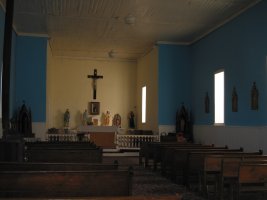
Soft ageless voices (seems to me)
sing “Gloria” in harmony.
In satin gown, colores rich,
the carved Maria’s in her niche;
below her feet I think I see …
“Mi santa Madre, plead for me …”
The votive candles’ softened glow
casts wisps of light; I do not know
if all I see is really there …
it matters not, I do not care.
If spirits bide, I feel they’re kin;
old friends to me for years they’ve been.
This haven of my gentle ghosts
is the sanctuary I love most.
Conquistadors’ old mysteries
and Sangre de Cristo majesties
still lend their sense of solitude
within this mountain interlude.
I’ve stepped into pine-scent air
and fragrant breezes chased all care.
Must leave this place of brief repast,
the sun is down and moon is cast
against the sky of velvet drape.
I hear an owl, see trees’ vague shapes.
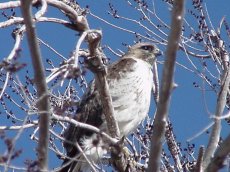
(Photo by JoAnn Hazel taken at Bitter Lakes)
“KA BOOM!” A noise above me bursts.
It frightens birds and shakes the earth!
That dissonanting sound of might
(a jet-fueled plane that rents the night)
returns me back to where I was not
to age of moon-walk astronaut.
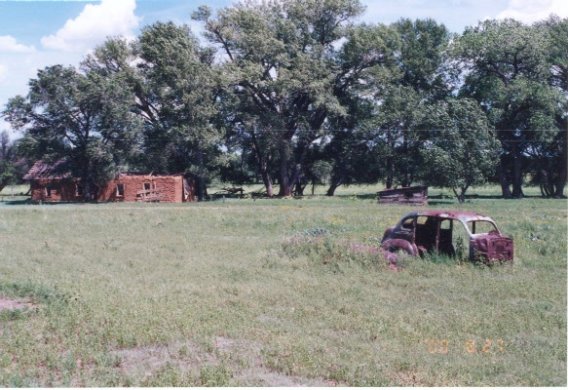
Yet, in New Mexico, if you look —
like in a beloved picture book —
you’ll see the remnants left behind:
a land of years (tierra de ayer) where time’s been kind.
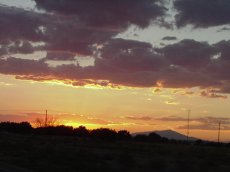
(Sunset photo taken by JoAnn Hazel of Roswell)
CONTINUING TO EXPLORE THE ORIGINS OF “BILLY THE KID” BONNEY

====================================
====================================
by Jan Girand
So … who was our Henry McCarty, William H. Bonney, “The Kid?”
Where did he come from, who was his ma, why did he do what he did?
Of his latter years (alas, so few), we know his story well
for many, including Pat Garrett, his stories loved to tell.
His antics, shoot-outs, hot pursuits are documented well
in books, in movies and in songs, stretched out so they would sell.
And sell they did, even in England, for folks there love a tale —
of strife, romance and intrigue as they quaff their brew and ale.
***
… to be continued …
(To see earlier portions of this poem, click the Archives button and go to Byway pages of the previous issues.)
=====================================
Pictured below is the Santiago Bonney Ditch as it appears today, more than 150 years after it was dug in northeast New Mexico by Englishman James Bonney in 1845 near his home and trading post along the Santa Fe Trail at a place then called La Junta, “the junction,” so-named because of the convergence of rivers.
In late summer of 1846, during their successful expedition in conquest of New Mexico and California for the U.S., Col. Stephen Watts Kearney and his Army of the West, and Col. Alexander W. Doniphan and his troops and caissons, camped at La Junta as guests of James Bonney, who supplied them his choicest beef. A few months later, Bonney was killed by Indians when he went in pursuit of them to retrieve his stolen horses. He went alone except for his young Indian guide, and took his wife’s fresh-baked tortillas for barter. That was a fatal mistake.
Santiago Bonney Ditch
=====================================
The origins and genealogy of Billy “The Kid” Bonney and his early life remain a mystery. So too is the mystery of why he, in the latter portion of his short life, adopted the name Bonney. Most published historians think that: a.) He began life in New York as Henry McCarty; b.) He changed his name to William Henry Antrim to match his stepfather’s after his mother’s marriage in Santa Fe in 1873; and c.) He adopted the name William H. or Billy Bonney in the last years of his life. Historians don’t know from where he acquired or why he adopted the Bonney name. Serious historians admit that they are uncertain of his origins, but think he might have been born in a New York City Irish slum in 1859. Both the place and the date of his birth could be incorrect.
We will continue to explore the possibilities together in future issues.
Rwm
====================================
Send an Email to editor@roswellwebmag.com , giving your Email address and your mailing address, and we will mail this (below) collector postcard to you with a Roswell, New Mexico cancellation stamp.
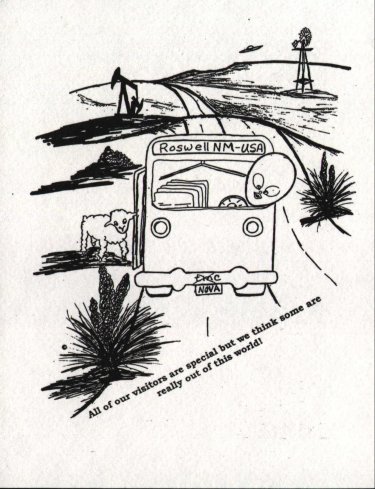
“All of our visitors are special, but we think some are really out of this world!”
Rwm
 Roswell Web Magazine
Roswell Web Magazine